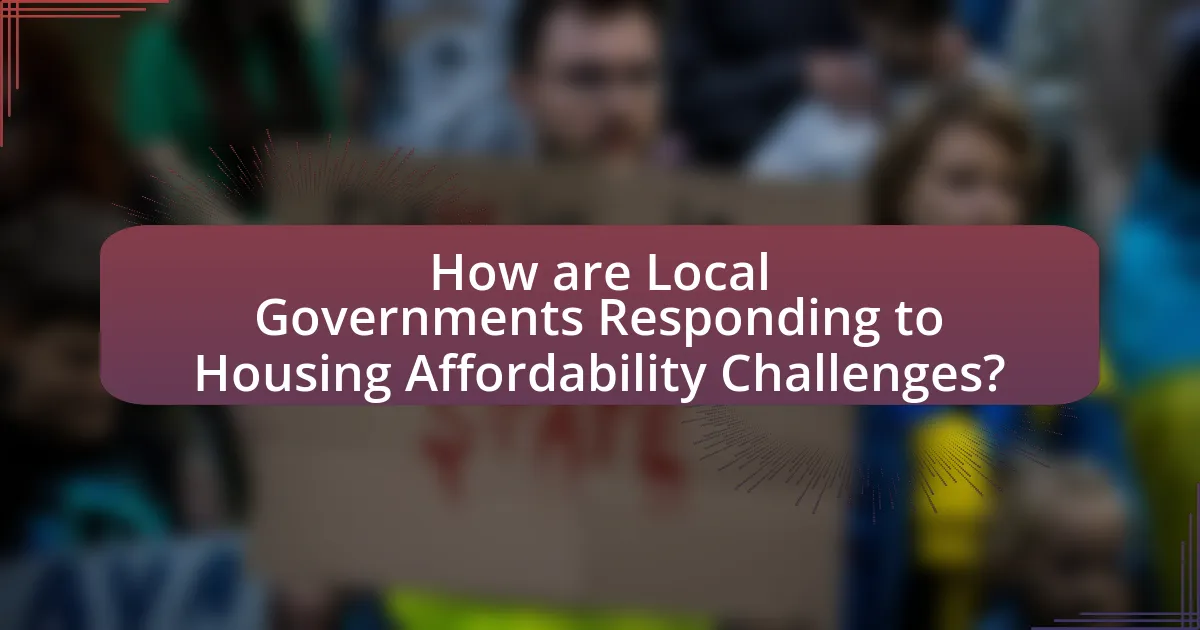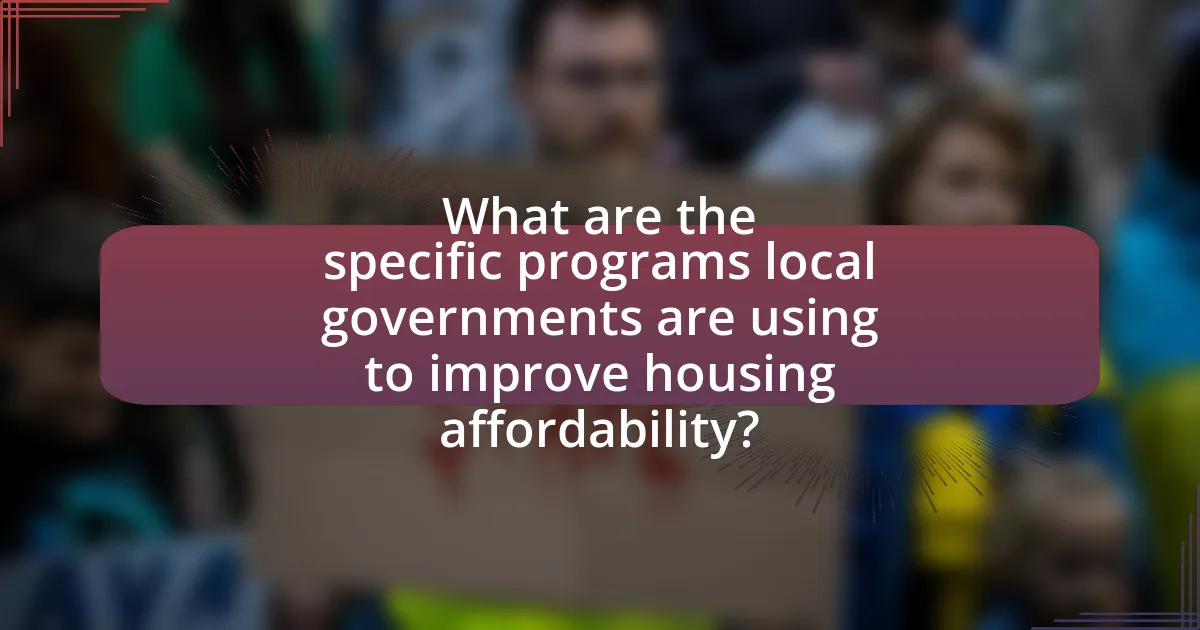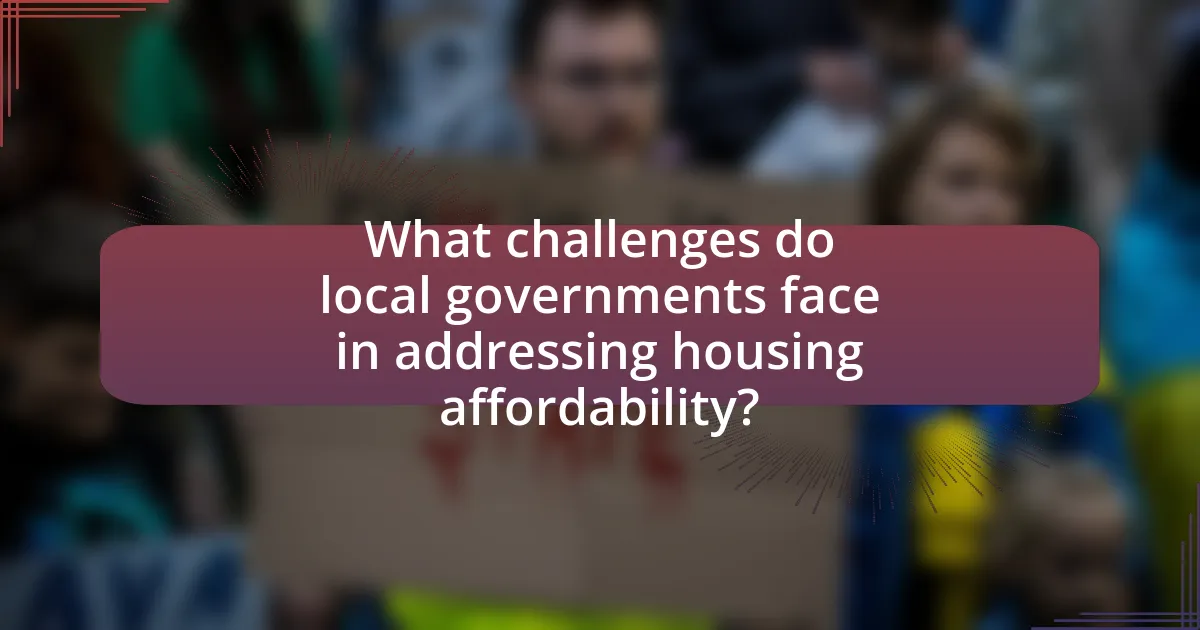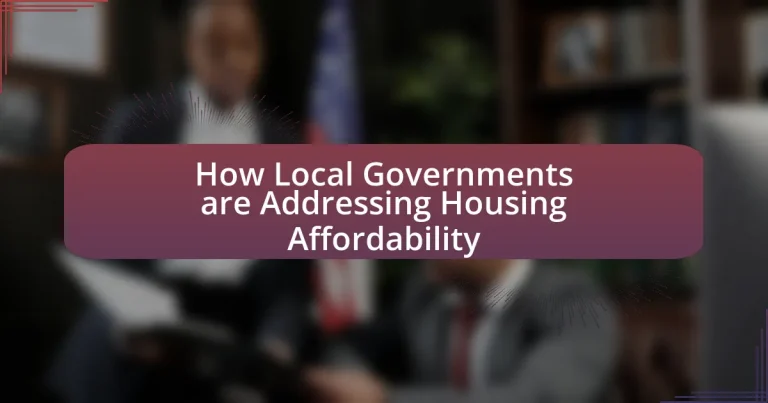Local governments are actively responding to housing affordability challenges through various strategies aimed at increasing the supply of affordable housing, providing financial assistance, and enacting zoning reforms. Key factors contributing to these challenges include rising housing costs, stagnant wages, and limited housing supply, exacerbated by restrictive zoning laws. Local governments are implementing programs such as inclusionary zoning, housing vouchers, and community land trusts to enhance access to affordable housing. Additionally, partnerships with non-profits and private developers are being formed to leverage resources and expertise, while addressing community opposition and funding limitations remains critical for the success of these initiatives.

How are Local Governments Responding to Housing Affordability Challenges?
Local governments are implementing various strategies to address housing affordability challenges, including increasing the supply of affordable housing, providing financial assistance, and enacting zoning reforms. For instance, many municipalities are investing in the construction of affordable housing units and incentivizing developers through tax credits or subsidies to include affordable options in their projects. Additionally, local governments are offering rental assistance programs to low-income families, which can help alleviate immediate financial burdens. Zoning reforms, such as allowing for higher density housing or mixed-use developments, are also being adopted to facilitate the creation of more affordable housing options. These actions are supported by data indicating that areas with increased affordable housing supply see a reduction in housing cost burdens for residents.
What are the primary factors contributing to housing affordability issues?
The primary factors contributing to housing affordability issues include rising housing costs, stagnant wages, and limited housing supply. Rising housing costs are driven by increased demand, particularly in urban areas, where population growth outpaces the availability of affordable units. Stagnant wages fail to keep up with these rising costs, leading to a greater proportion of income being spent on housing. Additionally, limited housing supply is exacerbated by restrictive zoning laws and lengthy permitting processes, which hinder the development of new housing. According to the National Low Income Housing Coalition, in 2021, there was a shortage of 7 million affordable rental homes for extremely low-income renters, highlighting the critical imbalance between supply and demand.
How do economic conditions impact housing prices?
Economic conditions significantly impact housing prices by influencing demand, supply, and financing options. When economic growth occurs, employment rates typically rise, leading to increased consumer confidence and higher demand for housing, which can drive prices up. Conversely, during economic downturns, job losses and reduced income can decrease demand, resulting in lower housing prices. Additionally, interest rates, which are affected by economic conditions, play a crucial role; lower rates make borrowing cheaper, stimulating demand and potentially increasing prices, while higher rates can dampen demand and lead to price declines. Historical data shows that during the 2008 financial crisis, housing prices fell by approximately 30% in many markets due to adverse economic conditions, illustrating the direct correlation between economic health and housing market dynamics.
What role does population growth play in housing demand?
Population growth significantly increases housing demand as more individuals require living spaces. As the population rises, the number of households typically expands, leading to a greater need for residential properties. For instance, the U.S. Census Bureau reported that the U.S. population grew by approximately 7.4 million people from 2010 to 2020, which directly correlates with increased demand for housing units. This heightened demand can lead to rising property prices and rental rates, impacting housing affordability.
What strategies are local governments implementing to address these challenges?
Local governments are implementing strategies such as increasing the supply of affordable housing, enhancing zoning regulations, and providing financial incentives for developers. For instance, many municipalities are revising zoning laws to allow for higher density housing and mixed-use developments, which can lead to more affordable units being built. Additionally, local governments are offering tax credits and subsidies to developers who commit to including affordable housing in their projects, thereby encouraging the construction of homes that are accessible to lower-income residents. These strategies are supported by data indicating that areas with relaxed zoning and financial incentives see a significant increase in affordable housing availability, addressing the pressing issue of housing affordability.
How do zoning laws affect housing development?
Zoning laws significantly influence housing development by regulating land use, density, and building types. These regulations can either facilitate or hinder the construction of new housing units, impacting overall housing supply. For instance, restrictive zoning can limit the number of housing units that can be built in a given area, leading to increased housing prices due to scarcity. According to a study by the National Bureau of Economic Research, areas with more flexible zoning laws tend to have higher rates of housing development and lower housing costs, demonstrating the direct correlation between zoning regulations and housing affordability.
What financial incentives are being offered to developers?
Local governments are offering various financial incentives to developers, including tax abatements, grants, and low-interest loans. These incentives aim to encourage the construction of affordable housing units. For instance, tax abatements can reduce property taxes for a specified period, making projects more financially viable. Additionally, grants can provide upfront capital to offset development costs, while low-interest loans can lower borrowing costs, facilitating investment in affordable housing projects. These strategies are designed to stimulate development in areas with housing shortages and promote community growth.

What are the specific programs local governments are using to improve housing affordability?
Local governments are implementing various programs to improve housing affordability, including inclusionary zoning, housing vouchers, and community land trusts. Inclusionary zoning mandates that a percentage of new developments be affordable for low- to moderate-income households, effectively increasing the supply of affordable housing. Housing vouchers, such as the Section 8 program, provide financial assistance to low-income families, allowing them to afford market-rate housing. Community land trusts acquire and hold land to ensure long-term affordability of housing by separating the ownership of land from the ownership of homes. These programs have been shown to effectively increase access to affordable housing options in various municipalities across the United States.
How do affordable housing initiatives work?
Affordable housing initiatives work by providing financial assistance, regulatory support, and development incentives to create and maintain housing that is affordable for low- and moderate-income individuals and families. These initiatives often include measures such as zoning changes to allow for higher density, tax credits for developers who build affordable units, and direct subsidies to renters or homebuyers. For example, the Low-Income Housing Tax Credit program has facilitated the construction of over 3 million affordable housing units since its inception in 1986, demonstrating the effectiveness of such initiatives in addressing housing affordability.
What types of affordable housing programs are available?
Affordable housing programs include public housing, housing choice vouchers (Section 8), low-income housing tax credits (LIHTC), and inclusionary zoning. Public housing provides government-owned units for low-income families, while housing choice vouchers allow recipients to rent in the private market with government assistance. The low-income housing tax credit incentivizes developers to create affordable rental units, and inclusionary zoning requires or encourages developers to include affordable units in new housing projects. These programs aim to increase access to affordable housing and address the housing affordability crisis faced by many communities.
How do these programs ensure long-term affordability?
These programs ensure long-term affordability by implementing mechanisms such as income-based rent adjustments, property tax incentives, and inclusionary zoning policies. For instance, income-based rent adjustments allow tenants to pay a percentage of their income towards housing costs, which helps maintain affordability as incomes fluctuate. Property tax incentives for developers encourage the construction of affordable housing units, ensuring that these units remain accessible over time. Inclusionary zoning policies require a percentage of new developments to be affordable for low- and moderate-income households, thus integrating affordable options within market-rate developments. These strategies collectively contribute to sustained affordability in housing markets.
What partnerships are local governments forming to enhance housing solutions?
Local governments are forming partnerships with non-profit organizations, private developers, and community groups to enhance housing solutions. These collaborations aim to leverage resources, share expertise, and implement innovative housing projects. For example, initiatives like the “Housing First” model involve local governments partnering with non-profits to provide immediate housing for the homeless, which has been shown to reduce overall costs associated with emergency services and improve community health outcomes. Additionally, public-private partnerships are increasingly utilized to finance affordable housing developments, as seen in cities like San Diego, where the city collaborates with developers to create mixed-income housing projects, addressing both supply and affordability challenges.
How do collaborations with non-profits impact housing initiatives?
Collaborations with non-profits significantly enhance housing initiatives by leveraging resources, expertise, and community connections. Non-profits often provide critical services such as advocacy, funding, and program implementation, which local governments may lack. For instance, partnerships with organizations like Habitat for Humanity have resulted in the construction of affordable housing units, demonstrating a tangible impact on housing availability. Additionally, non-profits can mobilize volunteers and community support, further amplifying the effectiveness of housing programs. Research indicates that such collaborations can lead to a 30% increase in project completion rates, showcasing their vital role in addressing housing affordability challenges.
What role do private sector partnerships play in addressing housing needs?
Private sector partnerships play a crucial role in addressing housing needs by leveraging resources, expertise, and innovation to create affordable housing solutions. These collaborations often result in increased investment in housing projects, enabling local governments to expand their capacity to meet demand. For instance, partnerships can facilitate the development of mixed-income housing, which integrates affordable units within market-rate developments, thus promoting inclusivity and diversity in communities. Additionally, private sector involvement can accelerate project timelines and reduce costs through efficient construction practices and access to advanced technologies. Evidence from various urban development initiatives shows that cities with strong private sector partnerships have successfully increased their housing stock and improved affordability, demonstrating the effectiveness of such collaborations in tackling housing challenges.

What challenges do local governments face in addressing housing affordability?
Local governments face significant challenges in addressing housing affordability, primarily due to limited financial resources and regulatory constraints. Many local governments operate under tight budgets, which restrict their ability to invest in affordable housing projects or provide subsidies. Additionally, zoning laws and land-use regulations often hinder the development of new housing units, particularly affordable ones, as they can impose high costs and lengthy approval processes. For instance, a report from the National Association of Realtors indicates that restrictive zoning can increase housing costs by up to 30%. Furthermore, local governments may encounter opposition from residents who resist new developments, fearing negative impacts on their neighborhoods, which complicates efforts to expand affordable housing options.
How do funding limitations affect housing projects?
Funding limitations significantly hinder housing projects by restricting the availability of financial resources necessary for development. When local governments face budget constraints, they often reduce investments in affordable housing initiatives, leading to fewer projects being initiated or completed. For instance, a report from the National Low Income Housing Coalition indicates that a lack of funding has resulted in a shortfall of over 7 million affordable housing units in the United States. This scarcity exacerbates housing affordability issues, as developers may be unable to cover construction costs or provide incentives for low-income housing, ultimately limiting access to safe and affordable homes for vulnerable populations.
What are the implications of budget cuts on housing initiatives?
Budget cuts significantly hinder housing initiatives by reducing funding for affordable housing projects and support services. This reduction leads to fewer new housing developments, increased homelessness, and diminished resources for existing programs aimed at assisting low-income families. For instance, a report from the National Low Income Housing Coalition indicates that a 10% cut in housing budgets can result in a loss of thousands of affordable housing units, exacerbating the housing crisis in many communities. Additionally, budget cuts can limit local governments’ ability to implement policies that promote housing stability and affordability, ultimately impacting the overall economic health of the area.
How can local governments secure additional funding for housing programs?
Local governments can secure additional funding for housing programs by leveraging federal grants, forming public-private partnerships, and implementing local tax incentives. Federal programs, such as the Community Development Block Grant (CDBG), provide substantial financial resources specifically for housing initiatives, with over $3 billion allocated annually to support local governments. Public-private partnerships can attract private investment, as seen in successful projects like the New York City Housing Authority’s collaboration with private developers, which has resulted in the creation of thousands of affordable housing units. Additionally, local tax incentives, such as property tax abatements or low-income housing tax credits, can stimulate investment in housing projects, evidenced by the 2017 report from the National Council of State Housing Agencies, which highlighted that states utilizing these incentives saw a significant increase in affordable housing development.
What community opposition do local governments encounter?
Local governments encounter community opposition primarily related to zoning changes, development projects, and affordable housing initiatives. Residents often express concerns about increased traffic, changes in neighborhood character, and potential declines in property values associated with new developments. For instance, a study by the Urban Institute found that 60% of community members opposed new affordable housing projects due to fears of overcrowding and strain on local resources. This opposition can significantly delay or derail local government efforts to address housing affordability, as public hearings and community meetings often reveal strong resistance to proposed changes.
How do NIMBY (Not In My Backyard) sentiments influence housing policies?
NIMBY sentiments significantly influence housing policies by creating resistance to new developments in local communities. This resistance often leads to stricter zoning laws and regulations that limit the construction of affordable housing, as residents prioritize maintaining the status quo over accommodating new projects. For instance, a study by the National Bureau of Economic Research found that areas with strong NIMBY opposition saw a 20% decrease in housing supply, exacerbating affordability issues. Consequently, local governments may face challenges in balancing community interests with the need for increased housing availability, often resulting in policies that favor existing residents over potential newcomers.
What strategies can be employed to engage communities in housing discussions?
To engage communities in housing discussions, local governments can employ strategies such as hosting public forums, utilizing social media outreach, and forming community advisory boards. Public forums allow residents to voice their concerns and ideas directly, fostering a sense of involvement and ownership in housing policies. Social media outreach can effectively disseminate information and gather feedback from a broader audience, ensuring diverse community representation. Community advisory boards, composed of local residents, can provide ongoing input and help shape housing initiatives, ensuring that the voices of those affected by housing policies are heard. These strategies have been shown to enhance community participation and improve the relevance of housing discussions, as evidenced by successful case studies in various municipalities where increased engagement led to more tailored and effective housing solutions.
What best practices can local governments adopt to enhance housing affordability efforts?
Local governments can enhance housing affordability efforts by implementing inclusionary zoning policies, which require developers to set aside a percentage of new housing units for low- and moderate-income residents. This approach has been adopted in cities like San Francisco, where inclusionary zoning has contributed to the creation of thousands of affordable units. Additionally, local governments can streamline the permitting process to reduce costs and time for developers, as seen in Minneapolis, which has led to increased housing supply. Furthermore, establishing housing trust funds can provide dedicated resources for affordable housing development, a practice successfully utilized in various states, including Massachusetts, where such funds have significantly supported affordable housing projects.
How can data-driven approaches improve housing policy effectiveness?
Data-driven approaches can significantly improve housing policy effectiveness by enabling local governments to make informed decisions based on empirical evidence. These approaches utilize data analytics to identify housing trends, assess community needs, and evaluate the impact of existing policies. For instance, cities that have implemented data-driven strategies, such as San Francisco, have used data to analyze housing supply and demand, leading to targeted interventions that address specific affordability challenges. Furthermore, research from the Urban Institute indicates that data-driven policies can enhance transparency and accountability, allowing stakeholders to track progress and adjust strategies in real-time. This evidence-based framework ultimately leads to more effective housing policies that better serve the community’s needs.
What role does community engagement play in successful housing initiatives?
Community engagement is crucial for the success of housing initiatives as it fosters collaboration between local governments and residents, ensuring that the housing solutions meet the actual needs of the community. Engaged communities are more likely to support housing projects, leading to smoother implementation and reduced opposition. For instance, a study by the Urban Institute found that projects with strong community involvement had a 30% higher success rate in meeting their objectives compared to those without such engagement. This highlights that when residents actively participate in the planning and decision-making processes, the resulting housing initiatives are more effective and sustainable.





